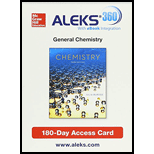
Interpretation:
Expanded octet formation by some of the elements is to be interpreted.
Concept introduction:
The concept of octet rule is valid for second period elements. Beyond the second period, the elements can have more than eight electrons around it.
Lewis structure is used to represent the bonding between the atoms and electrons in lone pairs that exist in the molecule.
In Lewis dot
In Lewis dot symbol, valence electrons are represented by dots.
Dots are placed above and below as well as to the left and right of symbol.
Number of dots is important in Lewis dot symbol but not the order in which the dots are placed around the symbol.
In writing symbol pairing is not done until absolutely necessary.
For metals, the number of dots represents the number of electrons that are lost when the atom forms a cation.
For second period nonmetals, the number of unpaired dots is the number of bonds the atom can form.
Atomic ions can also be represented by dot symbols, by simply adding (for anions) and subtracting (for cations) the appropriate number of dots from Lewis dot symbol.
Want to see the full answer?
Check out a sample textbook solution
Chapter 8 Solutions
Aleks 360 Access Card (1 Semester) For Chemistry
- QUESTION 2 What is the size (and sign) of the charge on the following ions? a) The ion that is formed by calcium, Ca b) The ion that is formed by phosphorus, P a) 2+ b) 3- a) 2- b) 3+arrow_forwardWhich of the following are ionic compounds? [Select all that apply.] CH3SH COI2 H3PO4 KHSO4 (CH3)2SO2 NH4CI KIarrow_forwardChapter 6-HW Est. Length: 2:00:00 Which of the following is the correct formula for the ionic compound that would form between calcium and phosphorous? O a) Ca3 P2 Ob) Ca₂ P3 c) Cap Arceli Lopez Lopez: Attempt 1 Od) Ca3 P Oe) Ca₂ P Xarrow_forward
- QUESTION 1 What are the following? In each case, give a short answer. Two examples are given below: Example 1: 'H, ²H, ³H Isotopes of hydrogen Example 2: Ammeter A device for measuring electrical current (a) Å (b) kg m² s-2 h (c) Ax - A(mv) 47 (d) Bond length (e) n; nf (in the H atom) (f) 6.626 × 10¬34 Js (g) 1 amu = 1.6605 × 10¬24 g (h) AE=hc (i) kg G) E, = -2.179 × 10¬18 J (k) NA = 6.022 × 1023 mol (1) A multiple bond (m) Radiation with A = 400 - 700 nm (n) Hertz (Hz) (0) c = 2.9979 x 10% m/s (p) X-rays, microwaves, UV lightarrow_forwardPractice Exercise 1Tetracarbon dioxide is an unstable oxide of carbon with thefollowing molecular structure:What are the molecular and empirical formulas of thissubstance? (a) C2O2, CO2 (b) C4O, CO (c) CO2, CO2(d) C4O2, C2O (e) C2O, CO2arrow_forwardWhich of the following are ionic compounds? [Select all that apply.] K3PO4 O H&PO4 O H2S O MgCl2 NH3 O NH4NO3 CH4arrow_forward
- Question2. Determine whether each of the electron configurations given below is an inert gas, a halogen, an alkali metal, an alkaline earth metal, or a transition metal. (a) 1s22s22p63s23p63d74s2 (b) 1822s22p63s23p6 (c) 1822s22p5 (d) 1822s22p63s2 (e) 1822s22p63s23p63d24s2arrow_forwardSome plant fertilizer compounds are HNO3, H2SO4, H3PO4, NH4NO3, and K2CO3. Which of these compounds contain both ionic and covalent bonds? (Select all that apply.)arrow_forwardWhat is the symbol of the element located in period 3 with the following Lewis dot structure. Input just the symbol. X .arrow_forward
- Question 10 Which chemical family contains has the smallest size atoms within each period? No new data to s MacBook Airarrow_forwardQuestion 1 of 39 Submit Predict the chemical formula for the ionic compound formed by the elements Cs and P 2- 3 Ca Reset > 3 4 7 ) (s) (1) (g) (aq) Cs • x H20 11 LOarrow_forwardPractice Exercise 1Although it is helpful to know that many ions have the electronarrangement of a noble gas, many elements, especially among themetals, form ions that do not have a noble-gas electron arrangement.Use the periodic table, Figure 2.14, to determine which ofthe following ions has a noble-gas electron arrangement, andwhich do not. For those that do, indicate the noble-gas arrangementthey match: (a) Ti4+, (b) Mn2+, (c) Pb2+, (d) Te2- , (e) Zn2+.arrow_forward
 Chemistry In FocusChemistryISBN:9781305084476Author:Tro, Nivaldo J., Neu, Don.Publisher:Cengage Learning
Chemistry In FocusChemistryISBN:9781305084476Author:Tro, Nivaldo J., Neu, Don.Publisher:Cengage Learning Chemistry: An Atoms First ApproachChemistryISBN:9781305079243Author:Steven S. Zumdahl, Susan A. ZumdahlPublisher:Cengage Learning
Chemistry: An Atoms First ApproachChemistryISBN:9781305079243Author:Steven S. Zumdahl, Susan A. ZumdahlPublisher:Cengage Learning

